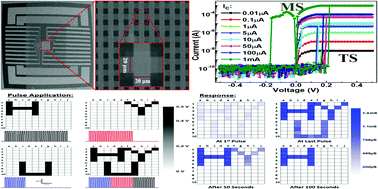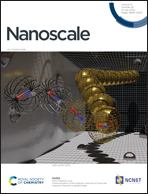The coexistence of threshold and memory switching characteristics of ALD HfO2 memristor synaptic arrays for energy-efficient neuromorphic computing†
Abstract
The development of bioinspired electronic devices that can mimic the biological synapses is an essential step towards the development of efficient neuromorphic systems to simulate the functions of the human brain. Among various materials that can be utilized to attain electronic synapses, the existing semiconductor industry-compatible conventional materials are more favorable due to their low cost, easy fabrication and reliable switching properties. In this work, atomic layer deposited HfO2-based memristor synaptic arrays are fabricated. The coexistence of threshold switching (TS) and memory switching (MS) behaviors is obtained by modulating the device current. The TS characteristics are exploited to emulate essential synaptic functions. The Ag diffusive dynamics of our electronic synapses, analogous to the Ca2+ dynamics in biological synapses, is utilized to emulate synaptic functions. Electronic synapses successfully emulate paired-pulse facilitation (PPF), post-tetanic potentiation (PTP), spike-timing-dependent plasticity (STDP), short-term potentiation (STP), long-term potentiation (LTP) and transition from STP to LTP with rehearsals. The psychological memorization model of short-term memory (STM) to long-term memory (LTM) transition is mimicked by image memorization in crossbar array devices. Reliable and repeatable bipolar MS behaviors with a low operating voltage are obtained by a higher compliance current for energy-efficient nonvolatile memory applications.

- This article is part of the themed collection: Nanoscale 2021 Lunar New Year Collection


 Please wait while we load your content...
Please wait while we load your content...